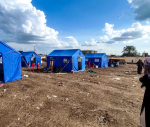Jordanian officials have long believed that Jordan is rich in uranium reserves.
Former prime minister Ali Abul Ragheb stated in an interview that the Jordanian government knew of the existence of uranium reserves in Jordan in the early 1990s, but “due to political reasons and the sensitivity of uranium … and since Jordan was coming out of political isolation after the second Gulf War invasion”, the subject was shelved (Al Ghad, July 13, 2010).
The subject of uranium was visited again in the 2000s, when nuclear engineers convinced the government that uranium reserves were large enough to be mined and attract as much as $40 billion in revenues (Ad Dustour, September 27, 2008).
Earlier on, a grant allowed Jordan to conduct an aerial radiation survey during which various potential exploration sites were located. One of those, in central Jordan, showed a high radiation rate and was called the “fertile zone”.
In 2008, the Jordan Atomic Energy Commission (JAEC) was formed to usher in a nuclear project that depended on uranium mining to fund the construction of nuclear power plants.
Three exploration agreements were signed between JAEC and international mining companies during 2008 and 2009.
The first surprise came when the Chinese Nuclear International Uranium Corporation (SinoU) decided to end its exploration operations in Jordan. More surprise surfaced when the British-Australian multinational Rio Tinto declared that while Jordan was very rich in phosphate, commercially viable uranium had not been found (Al Arab Al Yawm, April 20, 2011).
That left the French company Areva, which was awarded exploration in the “fertile zone” (which everyone else wanted).
JAEC soon changed the excavation agreement with Areva with an exclusive 25-year mining agreement, signed on February 21, 2010.
Areva had three years to come up with the results of its exploration.
Hundreds of French employees were brought to Jordan, and trenches were dug left and right in the “fertile zone”.
In the meantime, JAEC management kept releasing different numbers of uranium reserves, ranging from 64,000 tonnes to 220,000 tonnes.
On November 1, 2011, Areva released its findings, which showed that only 12,000 tonnes of uranium were available (an expert report stated that if the cut off was 45 parts per million, it will be 12,000 tonnes, but as low as 8,000 tonnes if the cut off were raised to 75ppm).
These were not commercial quantities, as Areva’s mining agreement with JAEC was to have a cut off of 250ppm and for a quantity of no less than 20,000 tonnes.
With experience of more than 50 years, Areva knew well that the building of a mine was likely to cost as much as $650 million in order to produce refined uranium ore, yellowcake.
Uranium extraction in Jordan was therefore not feasible, and exploration works halted in the “fertile zone”.
Undaunted, the JAEC cancelled the agreement with Areva and tried to lure the China National Nuclear Corporation (CNNC) to mine the “fertile zone”.
The CNNC replied immediately that the Jordanian uranium reserve was “a low-grade deposit” that it would be “unable to develop economically”.
This did not discourage the JAEC management, which declared that Areva did not work properly (Petra, November 11, 2012) and that much of its work was carried out by radiometry measurements rather than by lab analysis, even though on many occasions, JAEC had declared that samples were tested in its own labs as well as in Areva’s labs.
To prove this, JAEC revoked the UK auditors’ report (SRK Consulting UK Ltd.), which JAEC had commissioned earlier and which confirmed Areva’s findings, and found an Australian company (Coffey Mining Pty Ltd.) that could double the reserve (through an unpublished report) to up to 28,000 tonnes, without a mention of the cut-off values.
JAEC even commissioned a Rio Tinto employee to write an unpublished report on one square kilometre in the “fertile zone” to prove its point (Jordan Business, December 2013).
Today, after spending a substantial sum of money on explorations and having withdrawn from a non-feasible yellowcake adventure and from a long term but short-lived partnership with Areva, JAEC has suddenly turned to Russia for its first nuclear power plant (The Jordan Times, October 28, 2013).
It subsequently came as no surprise when JAEC declared the possible formation of a Russian-Jordanian uranium mining company to produce Jordanian yellowcake (Al Ghad, December 5, 2013).
To this end, the prime minister insisted in Parliament that the Jordanian uranium will suffice for 150 years (Al Rai, March 21, 2013).
And so the myth of Jordan’s yellowcake lives on.
The writer is president of the Jordanian Friends of Environment. He contributed this article to The Jordan Times.










